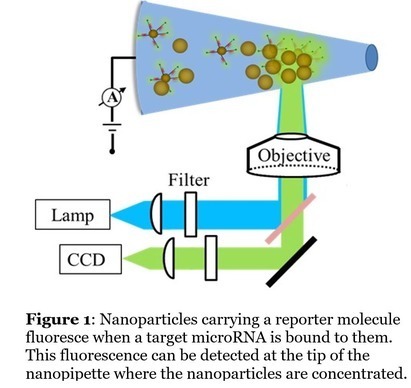Enhanced Sensitivity of Molecular Optical Sensor
Tech ID: 13-048
Inventor: Hsueh-Chia Chang, Shoupeng Liu, Yunshan Wang, Yu Yan, Satyajyoti Senapati
Date Added: September 30, 2020
Overview
Concentrated nanoparticles within the submicron tip of a nanopipette, create an intensified fluorescent signal, indicative of target nucleic acid

Technology Summary
Biological samples from patients may possess very limited amounts of nucleic acids. Thus in order to detect those nucleic acids, the standard process in the field is to first artificially amplify the number of nucleic acid molecules in the sample. However, this process is time-consuming, tedious, and prone to error. Therefore researches have expanded their efforts to find ways of detecting low levels of nucleic acids that do not require pre-amplification steps. Plasmonics-based optical sensors can meet this stringent sensitivity specification. However, current plasmonic sensors require the placement of the nucleic acids in plasmonic hotspots between nanostructures, which is extremely difficult to do for samples with a low target nucleic acid concentration.
Researchers at the University of Notre Dame have uncovered a methodology to detect as little as 1 femtomolar of target nucleic acid within a given sample. The method utilizes gold nanoparticles with functionalized nucleic acid probes. Once these probes attach to the target nucleic acid in the sample, the particles are assembled by the high electric field at a nanopipette to produce plasmonic hot spots. All the nucleic acid targets and their activated fluorescent reporters are in such hotspots, as they are co-assembled with the nanoparticles. The spacing between the nanoparticles can be adjusted by tuning the electric field to obtain maximum signal enhancement. The plasmonically enhanced intensity is so high that 1 fM or 100 copies can be detected with a low-cost CCD camera.
Market Advantages
- Can detect down to 1fM of target nucleic acid
- Can image fluorescent result with a normal CCD camera
- Does not require reverse transcription, DNA amplification, or PCR
Market Opportunities
- Total Addressable Market: $2.14B/yr
- Diseases Diagnostics
- Pathogen detection
- Academic/Laboratory Research
Technology Readiness Level
TRL4 – Lab Validation
Publications
Artificial helical microswimmers with mastigoneme-inspired appendages
DOI: 10.1063/1.4827915
Intellectual Property Status
US Patent 9,856,518
Contact
Richard Cox
rcox4@nd.edu
574.631.5158